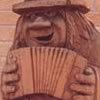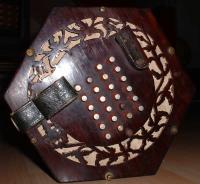-
Posts
2,097 -
Joined
-
Last visited
Everything posted by Theo
-

Introducing Our New Traditional Anglo Concertinas
Theo replied to wim wakker's topic in General Concertina Discussion
Anyone else having trouble seeing Wim's site? I'm on a Mac, tried several browsers, in both Firefox and Camino I get "Applet fphover started" in the progress bar at the foot of the screen. IE 5.2 hangs. Any suggestions? -
It is still possible that the valve is the problem if it is not able to lift properly when the note is played. If it is not that then the reed needs attention. If it has gone flat it is possible that the reed is cracked and needs replacing.
-
And as the valves are plastic, not leather, it is not an antique. How do you know the problem is with the plastic strips/valves? From the pictures I can't see anything wrong with them. Its normal for no valves to be fitted to the smallest reeds. If reedplate has fallen out you need to carefully sit it in the correct position - the shape will help - then use a pair of pliers to twist the little hooks round so that they clamp the reedplate in place. I don't think there is any wax holding your reedplates in place. Forget about finding a repairer in the next street - though you might be lucky. You will most likely have to send it to somewherer like the BBox. I'm in the UK, and I recently repaired an instrument from someone in Pittsburg. There is a list of repairers on this site.
-
I've tuned and played 20 key anglo and 2-row melodeons in 1/4 comma mean tone. Chords sound very sweet, especially in the upper octave.
-
Usually from the mid 40s up to 81! There are also several different types of Duet. Mccann is probably the most numerous, Crane/Triumph which were made in smaller numbers and Jeffries which are quite scarce, and Hayden which is a relative newcomer. Ther may be more. You might need to talk to your Dad to get some morre clues as to what he has in mind!
-

Glue Joints On Old Wooden Action
Theo replied to Daniel Hersh's topic in Instrument Construction & Repair
For the occasional spot of regluing liqid is ok. For the number of joints you have to do hot hide glue would be my choice. It gells quickly as it cools, which means that for small light parts you don't need to clamp. Just apply glue and press the parts together with gentle finger presure, hold while the glue gells (you'll learn by experiece how long that takes) then set aside for 24 hours. You should remove any loose or flaky glue, and glue that has squeezed out of joints. In the joint area remove any particularly thick bits. If you want to remove it all, moisten it and after some time for the water to soak in the glue will soften and be easy to remove. Any glue left will be softened by the new hot glue and won't spoil the joint. possibly the button is in two halves, split lengthways, if so you could separate the halves and glue in a new strip if leather. You do need to keep the flexibility to prevent buttons sticking in their holes. -
And if you do play with others it will depend on what they play. Stringed instruments can tune to you.
-

Glue Joints On Old Wooden Action
Theo replied to Daniel Hersh's topic in Instrument Construction & Repair
Daniel The type of construction you describe is very similar to that found in German concertinas, so there may be others who can advise you here. I'd just offer a couple of suggestions from experience with German concertina action. Glue: I would avoid all modern glues and use traditional animal glue/hide glue. Apart from the slight inconvenienec of having to heat it before use it has some very valuable properties: Its reveresible, it's very quick to apply and needs minimal clamping, it responds to humididty changes in a similar way to wood. A very cheap and convenient way of heating it is to use a jamjar in an electric baby bottle warmer. Buttons are connected to levers with strips of soft leather, these are likely to need replacing. On some rows the button mounts may be designed to be flexible. -
Tom On some concertinas the strap screw goes directly into wood, on others a threaded metal plate is fitted into the wood. If as I suspect yours is the first type you have a choice. A quick fix is to reduce the size of the hole by inserting a slip of soft wood, from a matchstick say. The more permanent method is to use the new screws with metal screw in "nut" that you can get from David Leese. With these you first drill out the hole to accept the brass insert - it should be a tight fit. Screw in the insert with a screwdriver, then fit the strap screw. You will almost certainly have to use the new thumbscrews as the threads are not the same as the old ones. If you your screw goes into a metal plate you can get a replacement from David Leese.
-
But Mark, you could keep the 'tina inside the piano!
-

I Want To Buy A Concertina, But I Have Questions.
Theo replied to thefirstcorby's topic in General Concertina Discussion
If the 30 key Hohner for $145 is new then I'd agree with the advice already given. If it is an older Hohner then it might be worth considering, especially if you are willing to do a bit of easy diy maintenance as shown here on c.net Older Hohners are usually re-badged Stagis. As far as I know all the older 30-key Hohners were made for them in Italy. Hohner moved most of their manufacturing to China a few years ago. -
Waltheof, it is a fairly typical German concertina of the type that gave the Anglo-German concertian its name when an English maker (Jones?) built a concertina with German note layout, but using "English" construction techniques. As well as wood levers they typically use large zinc reedplates with 5 pairs of reed on each plate. Some may have more than one reed per note. Both build quality and playability are usually poor compared with English built instruments.
-
Heating with a soldering iron does work remarkably well. I believe it is the expansion of the metal caused by the heat which does it. Even though the amount of movement is miniscule it can be just enough to break the grip of rust on its surroundings. The rust not only locks the threaded part of the bolt onto its brass "nut" but if the shank of the bolt is rusted it sticks to the wood all along the hole through the end. Heat can help to loosen both. Another trick is to tap the end of the bolt sharply with a hammer. It's important to support the bellows frame on something solid before trying this. If the screw slot is badly worn try cutting it deeper with a small hacksaw blade, but use heat as well before you apply the screwdriver. If necessary get a new screwdriver, or re-grind the blade so there are no rounded edges. Many concertina screws have been ruined by screwdrivers which are worn, or not the correct size. Theo
-
I'm not far from Middlesborough, if i can help! Theo
-
Why do all the box players look so grim, while everyone else appears to be smiling?
-
Chris Could the end plate have got out of line so that the buttons are travelling through two holes (one in the end, one in the action board) that are not aligned? Its the only theory I can find to esplain why the problem shoud only exist in one end. Close inspection of the buttons may show a wera pattern that would give you a clue as to where the buttons were rubbing excessivly.
-
I think I've partially answered my own question. From the fretwork pattern it seems probably that its made by George Case. Any more details would still be welcome.
-
I've been asked by the owner of this instrument if I can supply any information about its origins. There is no visible makers name, nor serial no. I don't recognise the fretwork pattern, but it is quite distinctive. I would be most grateful for any information on age or makers name.
-
Sounds like a very good price! As far as I know any old 56 key English concertina you find will probably have been made either by Wheatstone, or Lachenal, and will be a quality instrument. Even 4000 SEK would have been cheap! Congratulations.
-
For tuning the smallest reeds there is nothing to beat a lolipop stick with medium or fine grit wet & dry abrasive paper stuck on each side. The soon wear out but are very easy and cheap to make, and much kinder to the reeds than a file. And for bigger reeds where the above is too slow you need a swiss file. Not every file sold as "swiss" is actually made in Switzerland. Look for Vallorbe, or Grobet branded files, and expect to pay something like 10 GBP each. Cheap files are more expensive in the long run.
-
I've no connection with this sale, and I take no responsibility for it but here is a very nice looking starter concertina for anyone who wants a good inexpensive 30 key anglo to learn on. Its on here on Ebay Germany The button sleves on these often need replacing but that is a fairly simple diy job. Instructions here. Good luck!
-
You do meet such appreciative people here! Thanks Peter, I'll try and remember that wherever I'm selling something: "Now here is an opportunity to obtain my goods, I'm not asking £500, I'm not asking £400, I'm not even asking £300 or £200........" But seriously I came here to try and learn about concertinas, and I've not been disappointed. So many people freely sharing information that in many cases has been the result of a lifetime search. Thank you all.
-
Peter: the following is a quote from Paul on the Buy & Sell page on the main part of c.net "Free classified ads for all things musical (not just concertina-related) Be sure to also use the new Buy/Sell forum.Yes, I encourage you to post your item both here AND in the Buy/Sell forum to give your ad maximum exposure" So it seems BigYin is just following this guidance. Of course we could have a discussion about changing the rules, but I doubt it would have much impact on the operation of the forum. The essence of For Sale listings anywhere is to ignore those that don't interest one. Theo
-
Yes the sound may be different, but the Anglo system is not able to play in more keys than others. 30-key Anglo, English, and McCann and Crane duet systems are all fully chromatic.


